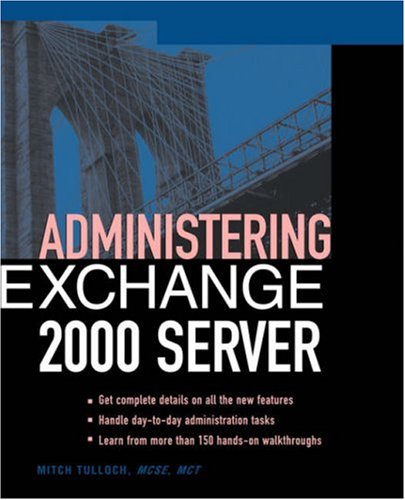

Most ebook files are in PDF format, so you can easily read them using various software such as Foxit Reader or directly on the Google Chrome browser.
Some ebook files are released by publishers in other formats such as .awz, .mobi, .epub, .fb2, etc. You may need to install specific software to read these formats on mobile/PC, such as Calibre.
Please read the tutorial at this link: https://ebookbell.com/faq
We offer FREE conversion to the popular formats you request; however, this may take some time. Therefore, right after payment, please email us, and we will try to provide the service as quickly as possible.
For some exceptional file formats or broken links (if any), please refrain from opening any disputes. Instead, email us first, and we will try to assist within a maximum of 6 hours.
EbookBell Team

0.0
0 reviews
ISBN 10: 0072127082
ISBN 13: 9780072127089
Author: Mitch Tulloch
CHAPTER 1 Installation
Installing Exchange
Hardware Requirements
Software Requirements
Installing the First Exchange Server
Postinstallation Features
New Services
CHAPTER 2 Administration Tools
Exchange Administration Tools
Installing the Exchange Administration Tools on a Windows 2000 Professional Client Machine
Customizing the MMC
Creating Custom MMCs for Administering Exchange
Administering Exchange with Terminal Services
Using Terminal Services to Administer Exchange
Summary
CHAPTER 3 Users
Active Directory Users and Computers
Mail-enabled versus Mailbox-enabled
Creating a Mailbox-Enabled User
Configuring a Mailbox-enabled User
Delivery Restrictions
Delivery Options
Storage Limits
Additional User Configuration Settings
Configuring and Testing Mailbox-enabled Users
Creating a Mail-enabled User
Changing a User from Mail-to Mailbox-enabled
Deleting a Mailbox-enabled User
Copying a Mailbox-enabled User
Summary
CHAPTER 4 Contacts
Standard and Mail-enabled Contacts
Creating a Mail-enabled Contact
Configuring a Mail-enabled Contact
Mail-Enabling a Standard Contact
Summary
CHAPTER 5 Groups
Groups in Windows 2000
The Scope of Things
Types of Groups
Using Groups in Exchange
Group Types and Exchange
Group Scopes and Exchange
Working with Groups
Creating a Mail-enabled Security Group
Configuring a Mail-enabled Security Group
Disabling a Mail-enabled Security Group
Mail-enabling a Standard Security Group
Hiding and Displaying Membership of a Mail-enabled Security Group
Creating a Mail-enabled Distribution Group
Summary
CHAPTER 6 Outlook
Exchange Clients
Installing Outlook
Configuring Outlook for Exchange
Using Outlook
Address Book
Groups and Group Membership
Configuring Delivery Services
Summary
microsoft exchange server administrator
exchange server 2019 best practices
exchange 2000 server
configuring exchange server 2019
exchange server 2019 cal
exchange server admin console
exchange server standard 2019 user cal
Tags: Mitch Tulloch, Administering, Exchange